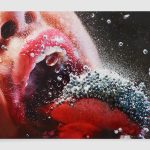Press Release
“The power of Minter’s work is that it always resonates on two levels: surface and depth. She is keenly aware of the power of the image to entice and titillate, but she never lets us stop with just those reactions,” states OCMA Director and CEO Todd Smith.“ She always makes us dig deeper into the social and personal underpinnings of why we experience the luscious imagery the way we do.”
From the beginning of her career, Minter has been embroiled in controversies over the relationship of her art to feminism, fashion, and celebrity. As an artist interested in these vexed cultural intersections has grown, her work has risked looking as effortless as a mirror held up to the most supercilious aspects of today’s “bling” lifestyle. Yet Minter’s work is not merely a mirror of our culture. This exhibition provides, for the first time, a critical evaluation of her practice as an astute interpretation of our deepest impulses, compulsions, and fantasies. Marilyn Minter: Pretty/Dirty includes the artist’s earliest artworks, a startling photo series titled Coral Ridge Towers. While still in school, the young Minter shot one roll of film of her mother, a drug addled, darkly glamorous woman who was “mom” for the artist. Completed in 1969 when Minter was 21, the works were not shown until decades later by Linda Yablonsky, a lifelong friend of Minter’s who used them as background images for a reading program. The series’ clear relationship to the artist’s later themes of degraded beauty has made these photographs into classics of the Diane Arbus-like genre. In Pretty/Dirty they are put back into their proper historical sequence as her earliest extant work. The exhibition spans Minters’ professional career and includes Little Girls #1 (1986) from her monumentally sized series completed in the mid-1980s titled “Big Girls, Little Girls.” Minter employed a mechanically applied enamel technique to portray a young girl looking at her distorted reflection in a funhouse mirror. Here Minter focuses on how girls are trained at an early age to look critically at their bodies, only to see themselves as flawed. Also on view from this series is Big Girls (1986), which combines the little girl gazing at her reflection with an appropriated image of Sophia Loren anxiously peering at Jayne Mansfield’s voluptuous figure spilling out of her dress.
“These works, like the others from this period, fused a feminist critique of the construction of gender and femininity with other postmodernist hallmarks of the 1980s, including the appropriation of mass-media imagery translated in a cool, detached, style of painting,” says Elissa Auther, co-curator of the exhibition. In every decade, Minter offers a smart woman’s critical look at issues that are otherwise presented by men for female consumption. The fashion world is full of male fashion house owners, designers, and photographers who fabricate images of femininity. Rather than a blatantly naive critique of fashion, Minter shows the dual nature and slight imperfections of herself and her fellow women, finding that true allure comes from the sensuality of imperfections. In one of her best-known paintings, Blue Poles (2007), Minter takes what is clearly a beautiful face and reveals flaws: a pimple, errant eyebrow hairs, and freckles. In real life these so called flaws make us human, attractive, and loveable, but in the beauty industry these imperfections are eradicated. In the age of Photoshop, where things such as freckles disappear from fashion and entertainment magazines, this painting can be understood as marking a final celebration of the attractiveness of the un-retouched human face. Minter’s recurring investigation of how the fashion industry expertly creates and manipulates desire led her to depict in many of her paintings an image of gorgeous accessories looking less than glamorous. In Dirty Heel (2008), viewers are treated to a close up of a woman’s dirty heel accessorized by an expensive looking pink-lined high-heeled shoe. In her 2014 video Smash, large female feet in bejeweled high-heeled shoes appear to be having a hell of a time—dancing, sliding across the floor, and smashing glass—all in Minter’s signature silver liquid. As we become aware of the subject’s tattooed swollen feet, which seem to convey a wealth of experience, viewers might at first feel a wave of aversion, but the joy of her smashing time is impossible to resist.
The exhibition explores in detail the myriad image choices Minter has made as a painter and photographer, the evolution of her style and technique, and her mode of production, including her organization of an unusual studio of assistants trained to create hyper-real, sometimes dizzyingly painted surfaces. Pretty/Dirty illustrates Minter’s progress from a curious youth looking critically at the domestic landscape before her to the media-savvy cultural producer whose images simultaneously define and critique our times.
Tags: Art, art exhibition, art exhibitions, Art Review, Art Reviews, marilyn minter, OCMA, Orange County Museum of Art, pretty/dirty
Posted in Art Reviews, Reviews |







Leave a Reply